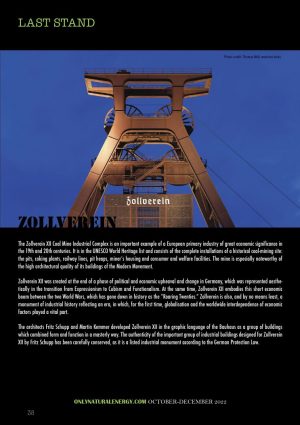 The Zollverein XII Coal Mine Industrial Complex is an important example of a European primary industry of great economic significance in the 19th and 20th centuries. It is in the UNESCO World Heritage list and consists of the complete installations of a historical coal-mining site: the pits, coking plants, railway lines, pit heaps, miner’s housing and consumer and welfare facilities. The mine is especially noteworthy of the high architectural quality of its buildings of the Modern Movement.
The Zollverein XII Coal Mine Industrial Complex is an important example of a European primary industry of great economic significance in the 19th and 20th centuries. It is in the UNESCO World Heritage list and consists of the complete installations of a historical coal-mining site: the pits, coking plants, railway lines, pit heaps, miner’s housing and consumer and welfare facilities. The mine is especially noteworthy of the high architectural quality of its buildings of the Modern Movement.
Zollverein XII was created at the end of a phase of political and economic upheaval and change in Germany, which was represented aesthetically in the transition from Expressionism to Cubism and Functionalism. At the same time, Zollverein XII embodies this short economic boom between the two World Wars, which has gone down in history as the “Roaring Twenties.” Zollverein is also, and by no means least, a monument of industrial history reflecting an era, in which, for the first time, globalisation and the worldwide interdependence of economic factors played a vital part.
The architects Fritz Schupp and Martin Kemmer developed Zollverein XII in the graphic language of the Bauhaus as a group of buildings which combined form and function in a masterly way. The authenticity of the important group of industrial buildings designed for Zollverein XII by Fritz Schupp has been carefully conserved, as it is a listed industrial monument according to the German Protection Law.




